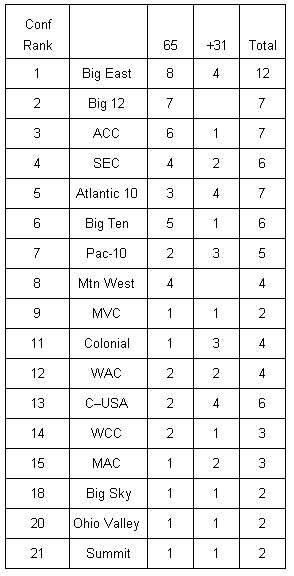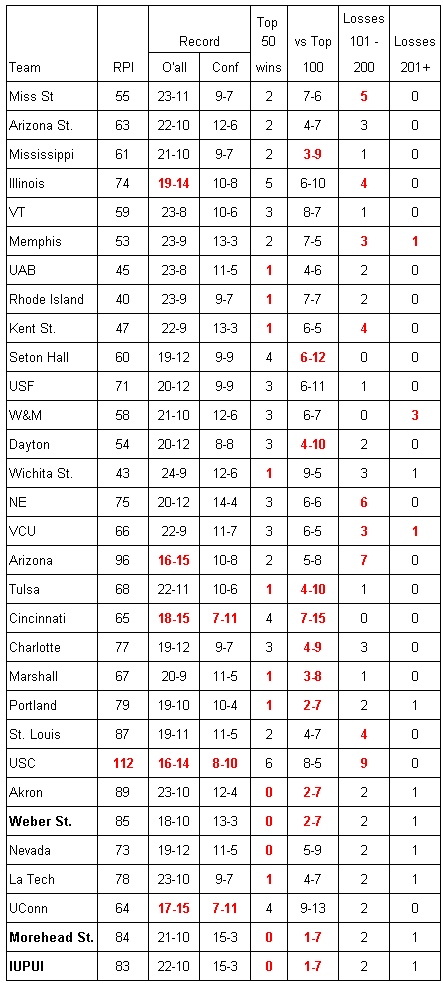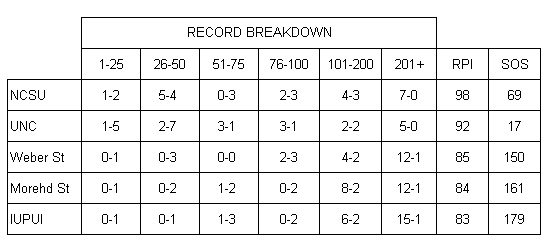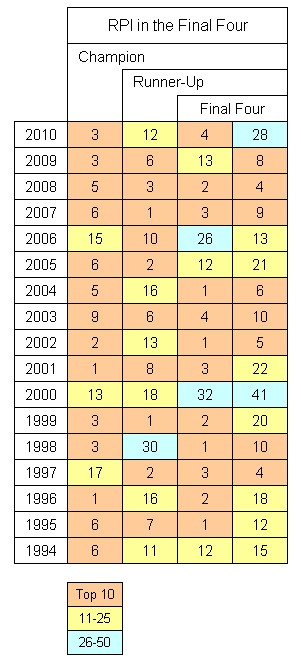The Dance Card is prepared annually by two college professors who have used statistical analysis techniques to analyze the at-large bids extended by the NCAAT Selection Committee. While their projections are only valid for the 65 team field, I thought it might be interesting to use their projections to see what a 96 team field would have looked like this year.
SIDE NOTE
I expect that there will be some discussion nationally about whether or not regular season conference winners should be guaranteed a slot in the 96 team field, regardless of their qualifications otherwise. But since I don’t think that the bottom half of Division 1 conferences should even be included in the national championship tournament, I’m certainly not going to include them in my analysis. (More on this later.)
So if we use the Dance Card to pick the “extra 31†teams, here is what we get in order of “strongest†to “weakestâ€:
Random Observations
I expect that the top 2/3 or so of these teams would appear on nearly any such list. Arguments will naturally pick up over the last teams in, no matter how many are included. But the real point of this exercise is to look at the “resumes†far more than the team names.
Those items noted in red are things that immediately tend to trigger my gag reflex when considering qualifications for a national championship tournament:
– RPI ranking 100+
– Overall records near .500
– Losing conference records
– 0/1 Top 50 wins
– Record against Top 100 < 0.333
- 4 or more losses to 101+ teams
- More than one loss to 201+ teams
As discussed by many people, there is simply no team here with a resume that screams out that they were unjustly left out of the 65 team field. Why TV networks would be willing to substantially improve the NCAAT’s current contract for the opportunity to show off this motley collection of teams is simply beyond me.
Now let’s parse these 31 teams along with the 65 team field and take a look at the conferences with multiple selections:

By my count, 32 teams in the 65 team field came from the six BCS conferences. This means that 26 of the 34 at-large bids went to teams from the major sports conferences.
In the 31 extra teams, only 11 of those bids went to teams from the BCS conferences. The big winners in the expanded field will be teams from the true mid-major conferences.
The teams in the bottom half of Division 1 (ie low-majors), simply don’t compete with the conferences in the top-half. Further evidence of this comes from the fact that only three teams from the weaker sisters show up at the bottom of the expanded field. Here is another look at the three low-major teams that were highlighted in the first table:
Just because App St beat Michigan one time doesn’t meant that they are ready to join the Big 10. The same line of reasoning applies to the low-major basketball teams. As illustrated by these three teams, the low-majors generally haven’t beaten anyone of note and too often haven’t even played anyone of significance.
If I were NCAAT czar for the day, I would reinstitute Div I-AA and move the bottom 15 or 16 conferences back to where they belong. Use the NIT to give these teams a chance at actually competing for a national title. In the NCAAT, they are little more than speed bumps on the Road to the Final Four.
WHAT ABOUT THE NIT?
There are two immediate questions that come to mind:
– What will a 96 team NCAAT do to the NIT?
– Since NCSU and UNC were picked for the NIT, wouldn’t they have been picked for a 96 team NCAAT?
The first question is fairly easy to dismiss….who could possibly care about the NIT? It has been irrelevant for the 40+ years that I have watched college basketball and should have been killed long ago. But since the NCAA now owns the NIT, you can probably count on them continuing the NIT as long as it makes money.
Now for the second question concerning UNC and NCSU, let’s answer a question with a question. What do UNC/NCSU have in common with the three low-major teams outlined above?
Simple…..None of them belong in the same discussion as a national championship tournament.
Let’s put all five teams under the same microscope:
The conclusions seem obvious to me.
While it is possible (likely?) that the NCAA would reject all five teams, this table illustrates the type of decision that the Selection Committee will be forced to make. They have two basic choices:
– Look for the least objectionable teams to fill the tournament.
– Use the extra slots as welfare for the little guys (and I mean really little guys).
FINAL THOUGHTS
One of the catch phrases that I’ve seen attached to the expanded NCAAT is that this will give more teams a chance to win a national title. So here’s one last table that illustrates the stupidity of that claim:
Bottom line:
When the dust settles, the glass slipper just doesn’t fit on bad teams. And make no mistake about it, expanding the NCAAT to 96 teams will add far more bad teams than teams that deserve to be in a national championship tournament.







You must be logged in to post a comment.